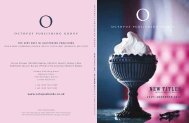pdf 1 - exhibitions international
pdf 1 - exhibitions international
pdf 1 - exhibitions international
Create successful ePaper yourself
Turn your PDF publications into a flip-book with our unique Google optimized e-Paper software.
Revised &<br />
Updated Edition
vi<br />
vii
HOYNINGEN-HUENE, MASTER OF<br />
THE SCENIC PHOTOGRAPH<br />
George Hoyningen-Huené had an<br />
obsession: to convey everything he<br />
possibly could about fashion, including<br />
its ability to generate emotion<br />
through gesture and setting. And all<br />
of this he meant to transmit through<br />
photography.<br />
Hoyningen-Huené was also a baron.<br />
His father, from St. Petersburg, had<br />
been in charge of the tsar’s stables,<br />
and his mother was an American<br />
from Michigan, the daughter of a highranking<br />
diplomat assigned to the<br />
imperial court. The family fled Russia<br />
when the revolution broke out, and<br />
George settled in Paris. The French<br />
capital was in a permanent state of<br />
artistic effervescence, animated by<br />
the dadaist, cubist, surrealist, expressionist,<br />
and futurist schools. The<br />
young Russian studied drawing with<br />
the cubist painter André Lhote and<br />
secured employment as an illustrator<br />
with the French edition of Vogue in<br />
1925. However, he soon realized that<br />
his true passion was photography,<br />
and he applied to it all the knowledge<br />
he had acquired in the artistic and<br />
theatrical circles he moved in. Rather<br />
than merely making a pictorial record<br />
of the clothing worn by his models,<br />
he would integrate the posed model<br />
into an evocative scene through<br />
atmosphere, lighting, and background.<br />
Hoyningen-Huené created in his<br />
studios the illusion that behind his<br />
models there existed a beach with sun<br />
and sand. He introduced onto the<br />
set automobiles, chairs, plants, sunshades—whatever<br />
might suggest real<br />
life and real fashions being shot outdoors.<br />
One of his most famous pictures,<br />
published in July 1930, shows<br />
a couple in bathing suits who seem to<br />
be on a diving board looking out over<br />
the sea. It was in fact taken on the<br />
SEPTEMBER 15, 1933<br />
The model (Mademoiselle<br />
Koopman) and the dress (by<br />
Augusta Bernard) appear<br />
against a backdrop designed<br />
to highlight the figure in the<br />
characteristic manner of<br />
Hoyningen-Huené.<br />
69
FIRST IN COLOR<br />
Edward Steichen, then the<br />
magazine’s head photographer,<br />
took this picture for<br />
the July 1, 1932, cover.<br />
The tanned figure with the<br />
beach ball became the symbol<br />
of the new type of athletic,<br />
active, healthy woman.<br />
A NEW ERA: COLOR<br />
PHOTOGRAPHY AND<br />
THE COVER<br />
The impact of the cover for July 1,<br />
1932, a color photograph by Steichen<br />
of a girl in a bathing suit, was decisive<br />
for the future of Vogue. As the<br />
Photography Era progressively<br />
replaced the Illustration Era, Vogue’s<br />
experiences with color photographs<br />
for covers assumed particular relevance<br />
in that very few magazines then<br />
had such covers. Either the magazines<br />
did not have the technical know-how,<br />
their images lacked quality, or photo<br />
covers were simply too costly to<br />
produce. It is worth pointing out that<br />
Time magazine started using color on<br />
its covers only in 1926, a year before<br />
it instituted its famous red border;<br />
the use of color photographs, however,<br />
on its cover had to wait several<br />
decades. National Geographic—one<br />
of the first publications to experiment<br />
with color photography on its inside<br />
pages, in 1916—waited until 1959 to<br />
bring out a cover in four colors. And<br />
Life, the premier photo magazine<br />
launched in 1936, kept to black-andwhite<br />
covers for several years. Leading<br />
the way in 1932 with its Steichen<br />
photo, Vogue was a true pioneer in<br />
the use of color photography on<br />
magazine covers.<br />
The Nast years at Vogue had already<br />
seen three different stages in cover<br />
illustration, as chapter 2 has shown.<br />
The consistent use of color dated<br />
to 1909, with American artists illustrating<br />
the fashions of the Belle<br />
Époque in styles ranging from great<br />
realistic detail to a high degree of fantasy.<br />
Starting in 1916 the magazine<br />
imported illustrators trained at Paris’s<br />
École Nationale des Beaux-Arts, who<br />
depicted fashion from their avantgarde<br />
artistic standpoints. Then in the<br />
1930s the style of illustration again<br />
began to favor explicit detail. With the<br />
dawn of the Photography Era in 1932,<br />
the documentary tendency in covers<br />
was reinforced, and color photography<br />
ended up totally dominating the<br />
field by the end of the decade.<br />
This gradual change in the covers<br />
was guided by the perceptions of the<br />
editor, who was seeking the most<br />
effective way to attract contemporary<br />
readers. Early in the 1930s, photography,<br />
which had already established its<br />
presence inside the magazine, seemed<br />
the best way to communicate its contents.<br />
Alexander Liberman recalled,<br />
from his period as art director, that<br />
“the reason was that the artist had to<br />
commit himself to reproducing a<br />
dress; a photographer was simply taking<br />
a picture of a beautiful woman.<br />
You can’t ask Matisse to copy a dress<br />
pattern. Yet a photographer clicks the<br />
shutter and it’s done.”<br />
105
MODELS:<br />
THE FACES<br />
OF FASHION<br />
For decades, fashion photography<br />
attempted to portray the archetypal<br />
woman. The tastes and demands of<br />
each era pointed to an ideal in feminine<br />
beauty: Sometimes young women<br />
were narrow waisted, at other times<br />
less so. Their hair was long or short,<br />
blonde or brunette or auburn. Their<br />
bodies were sometimes ultraslender,<br />
sometimes clothed to enhance the<br />
roundness of their breasts. Those different<br />
ways of showing female beauty<br />
found a marvelous vehicle in women’s<br />
magazines—and in the models themselves.<br />
It was they who over the years<br />
made known the face of fashion, its<br />
novelties and its attractions. They<br />
became the prime sine qua non of an<br />
industry that relied on style, elegance,<br />
glamour, and the women’s fantasy of<br />
seeing themselves and being seen<br />
as attractive.<br />
The first live mannequins were the<br />
wives of the designers, who wore their<br />
husbands’ creations to show them<br />
to clients. Next came society ladies<br />
who were photographed in their own<br />
dresses, and then actresses who<br />
posed in studios and conferred a<br />
certain professional air on the metier.<br />
But it was in the 1920s that professional<br />
modeling began to take hold in<br />
the United States. This was a time<br />
when photographers were undertaking<br />
increasingly sophisticated fashion<br />
productions, employing young<br />
unknowns with beautiful faces and<br />
perfect bodies who wore impeccably<br />
the creations of the fashion designers.<br />
TWELVE BEAUTIES<br />
In 1947 Vogue asked Irving<br />
Penn to do a group portrait<br />
of the most photographed<br />
models of the decade.<br />
They were dressed by the<br />
American designers Claire<br />
McCardell, Hattie Carnegie,<br />
Traina-Norell, Nettie<br />
Rosenstein, and Charles<br />
James. From left to right,<br />
the models are Meg Mundy,<br />
Marilyn Ambrose, Helen<br />
Bennett, Dana Jenney, Betty<br />
McLauchlen (on stepladder),<br />
Lisa Fonssagrives, Lily<br />
Carlson, Dorian Leigh<br />
(reclining), Andrea Johnson,<br />
Elizabeth Gibbons, Muriel<br />
Maxwell (on stepladder), and<br />
Kay Hernan.<br />
117
05Vogue_2ndpass 5.0 N:05Vogue_2ndpass 5.0 N 3/20/12 5:03 PM Page 130<br />
THE LIBERMAN STYLE<br />
Alex Liberman was the last important<br />
person to join the company before<br />
Condé Nast’s death. His arrival at<br />
Vogue was attended by a certain<br />
amount of confusion. Liberman, former<br />
managing editor of the French<br />
photo magazine Vu, had been raised<br />
in St. Petersburg and Moscow and<br />
educated in London and Paris, where<br />
he took art lessons from the cubist<br />
painter André Lhote, studied architecture<br />
at the École Nationale des Beaux<br />
Arts, and worked with the poster artist<br />
Cassandre. As soon as he arrived in<br />
New York, Liberman got in touch<br />
with Lucien Vogel, the founder of Vu,<br />
who had also fled France. Vogel was<br />
now an adviser to Nast and was a<br />
close friend of Liberman’s compatriot<br />
Iva Patcévitch, who would soon<br />
become president of the company.<br />
Vogel and Patcévitch agreed that<br />
Liberman’s credentials suited him to<br />
work at Vogue, especially because<br />
Nast was contemplating changes to<br />
the magazine’s visual presentation.<br />
Patcévitch promised to talk to his<br />
boss. In the meantime Liberman had<br />
made an appointment with the art<br />
director, Mehemed Fehmy Agha, and<br />
presented himself at Agha’s office at<br />
Vogue. Agha, also born in Russia<br />
but of Turkish parents, was nicknamed<br />
the Terrible Turk by fellow workers<br />
because of his imposing presence<br />
and imposing girth, his monocled eye,<br />
and his sarcastic and disdainful treatment<br />
of the people he dealt with.<br />
He was, however, deeply respected<br />
for the professionalism with which he<br />
had modernized the visual style of the<br />
company’s magazines. At his interview<br />
it was agreed that Liberman would<br />
have a chance to show his worth. The<br />
following Monday he was told to lay<br />
out a double-page spread that would<br />
carry illustrations by the fashion artist<br />
Jean Pagès. After devoting that week<br />
to the project, Liberman was called<br />
into Agha’s office on Friday afternoon.<br />
Agha pointed out the failings he<br />
found in the layout and concluded<br />
laconically: “I’m sorry, you are not<br />
right for Vogue.”<br />
A dejected Liberman picked up the<br />
check for his work and returned to his<br />
hotel. Astonishingly, a few minutes<br />
later the telephone rang and he heard<br />
the voice of Mary Campbell informing<br />
him that her boss, Condé Nast, wanted<br />
to see him on Monday morning. In<br />
their book Alex: The Life of Alexander<br />
BEFORE AND AFTER<br />
The cover for May 15, 1941,<br />
revealed the creativity of the<br />
new designer Alexander<br />
Liberman, who imaginatively<br />
added lettering to a Horst photo<br />
(left), to convert the beach ball<br />
into the O of “Vogue.”<br />
Liberman, one of the best accounts<br />
of the man and his work, Dodie<br />
Kazanjian and Calvin Tomkins quote<br />
Liberman recalling the occasion of his<br />
first meeting with Condé Nast in his<br />
vast office:<br />
You had to walk the length of this<br />
huge room, and there was Condé, at<br />
a banker’s desk, wearing his little<br />
pince-nez. . . . it became clear very<br />
quickly that Nast did not know that<br />
Agha had already hired and fired me.<br />
We talked about various things—Vu,<br />
and French publishing, and Vogel—<br />
and I showed him a certificate I had<br />
brought along, for a prize I had won<br />
at the Universal Exposition in Paris in<br />
1937. It was for a photo montage<br />
display on how magazines are created,<br />
and it had won a gold medal.<br />
There was this certificate with my<br />
name on it, although to tell the truth<br />
I don’t really remember doing the<br />
montage. The minute Nast saw it, he<br />
said, “Well, a man like you must be<br />
on Vogue.” And he pressed a buzzer,<br />
called Mary Campbell, and said,<br />
“Please send in Dr. Agha.” Agha<br />
came in while I was sitting there.<br />
Nast said, “Dr. Agha, this is Mr.<br />
Liberman. I would like him to be in<br />
P.130 M P.131 M<br />
131
VERUSCHKA August 15, 1965 MARISA BERENSON January 15, 1966 VERUSCHKA November 1, 1966<br />
WILHELMINA February 1, 1965<br />
MIA FARROW August 15, 1967 CATHERINE DENEUVE February 1, 1971 ELIZABETH TAYLOR April 15, 1971<br />
ALI MCGRAW March 1, 1970 KATHERINE ROSS May 1, 1968 BARBRA STREISAND March 15, 1966<br />
CELEBRITIES<br />
During the Vreeland years,<br />
the Vogue cover frequently<br />
carried images of celebrities,<br />
most of them movie stars,<br />
reflecting the bond between<br />
fashion and popular culture.<br />
EXAGGERATION<br />
Vreeland’s idea was to<br />
transmit trends, whether the<br />
fashion of colored hair or<br />
flower-printed apparel,<br />
with the utmost possible<br />
exaggeration.<br />
The Vogue covers of the 1960s clearly<br />
reflected the changes occurring in<br />
society and in fashion. Editorially, these<br />
changes occurred on several levels:<br />
From the beginning, the mission of<br />
the cover models had been to transmit<br />
glamour and elegance. Their bearing<br />
was aristocratic, their beauty refined<br />
and restrained. They projected an<br />
image of the ideal woman—socially well<br />
placed, a good wife, an accomplished<br />
hostess—for that image was what<br />
sold magazines. But with the 1960s<br />
the predominant concepts shifted:<br />
The models broadcast sexuality and a<br />
more liberated image, less oriented<br />
toward romance and luxurious domesticity<br />
than toward self-realization.<br />
The model’s face became the central<br />
image of the cover, with attention<br />
focused on the eyes and mouth. The<br />
eyes invariably looked straight at<br />
the camera. It was the lips, however,<br />
that gave a sensual touch to the<br />
image: They had to be slightly parted,<br />
expressing a provocative sense of sexual<br />
freedom. Makeup and hair became<br />
fundamentally important, and the art<br />
director assumed a growing influence<br />
over the composition of the cover.<br />
As the face became the primary<br />
vehicle to convey the identity and style<br />
of the magazine, the cover conveyed<br />
more information about cultural trends<br />
than practical ideas about fashion and<br />
beauty. Covers showed new fashions<br />
at their extreme, not alternative ways<br />
to adopt the fashion in part or in moderation.<br />
If exaggeration was the order<br />
of the day in makeup, the covers<br />
would exaggerate that trend even<br />
more, with images painted around the<br />
eyelashes or the cheeks.<br />
To transmit these ideas of fashion and<br />
beauty, Vogue created its own team<br />
of iconic faces—among them Jean<br />
Shrimpton, Marisa Berenson,<br />
Veruschka, Twiggy, Lauren Hutton,<br />
and Penelope Tree. It also found that<br />
young actresses who embodied the<br />
current movie trends were effective<br />
exponents of the new informal, eccentric,<br />
and bold fashions. Emerging<br />
actresses who appeared on the<br />
covers of Vogue were Julie Christie,<br />
Mia Farrow, Ursula Andress, Katherine<br />
203
SCANDAL<br />
In the same May 1975<br />
issue that carried Newton’s<br />
photos from Saint-Tropez,<br />
another fashion shoot<br />
touched off readers’ anger,<br />
and certain states even<br />
banned the sale of the issue.<br />
The pictures were taken<br />
by Turbeville in a public bathhouse<br />
in New York. Many<br />
saw the five models as<br />
portraying a lesbian scene.<br />
DEBORAH TURBEVILLE:<br />
EROTICISM WITH<br />
WOMAN’S EYES<br />
Newton’s fashion shoot in Saint-Tropez<br />
was published, perhaps by coincidence,<br />
in the same May 1975 issue<br />
as another piece that scandalized<br />
many readers. The photographer was<br />
Deborah Turbeville, an American who<br />
had been by turns a model and assistant<br />
to designer Claire McCardell,<br />
then a fashion editor at Harper’s Bazaar<br />
and Mademoiselle. She had become<br />
a photographer after participating in a<br />
seminar held by Richard Avedon and<br />
art director Marvin Israel, and had just<br />
been brought to Vogue by Alexander<br />
Liberman. The offending spread,<br />
ten pages on bathing suits, was her<br />
debut in the magazine. The sitting<br />
depicted five slim girls in beach attire<br />
against the stark, spartan background<br />
of a disused bathhouse on Thirtythird<br />
Street in New York. In the most<br />
controversial of the photographs one<br />
of the models, the one closest to the<br />
camera, seems to be masturbating.<br />
Turbeville recalls in On the Edge:<br />
“When we made the prints I knew<br />
that they were spectacular, and then I<br />
heard that Mr. Liberman thought they<br />
were extraordinary and that they were<br />
getting these huge spreads. When<br />
the magazine came out there was an<br />
explosion, because of what Helmut<br />
had done too. People began talking<br />
about the pictures being immoral, and<br />
saying was it Auschwitz or a lesbian<br />
scene or an orgy. Or were they in an<br />
insane asylum. But if you start out trying<br />
to do an insane asylum or a lesbian<br />
scene or an orgy it looks fake. It<br />
is only when you don’t set out to do it<br />
that things come off.”<br />
Liberman, who played a leading<br />
role in the magazine’s sensual<br />
approach to fashion, was an ardent<br />
defender of “porno-chic” as produced<br />
by Turbeville and Newton. However,<br />
Turbeville tried to differentiate her<br />
style, vision of women, and eroticism<br />
from those of male photographers.<br />
“I am totally different from photographers<br />
like Newton and Bourdin,” she<br />
is quoted as saying in Polly Devlin’s<br />
Vogue Book of Fashion Photography:<br />
The First Sixty Years. “Their exciting<br />
and brilliant photographs put women<br />
down. They look pushed around in<br />
a hard way, totally vulnerable. For<br />
me there is no sensitivity in that. I<br />
don’t feel the same way about eroticism<br />
and women. Women should<br />
be vulnerable and emotional; they can<br />
be insecure and alone; but it is the<br />
psychological tone and the mood that<br />
I work for.”<br />
237
THE PROVOCATIVE<br />
LOOK OF<br />
STEVEN KLEIN<br />
No photographer on the Vogue team<br />
today is doing more to erase the<br />
boundaries between fashion and art,<br />
or between popular culture and fine<br />
arts, than the American Steven Klein.<br />
And he is doing so with memorable<br />
and iconic images that alter and<br />
sometimes subvert traditional notions<br />
of glamour and beauty. “The thing that<br />
gets frustrating about fashion,” he told<br />
the authors, “is that you always want<br />
to respond to ideas that reflect what’s<br />
happening in the world, what’s in the<br />
street. You don’t want to just fabricate<br />
these dream lives of these idealized<br />
Barbie dolls that don’t even exist anymore.”<br />
Klein’s visual subtexts abound<br />
in provocation, sexual fears and<br />
desires, suave sadism, touches of<br />
transgression, and incendiary energy.<br />
His portraits generally offer provocative<br />
and somewhat somber studies of<br />
celebrities, which are conceived in<br />
deliberate contrast to the fawning and<br />
flattering images of those stars in the<br />
mass magazines.<br />
In his fashion shoots, Klein displays<br />
designer clothes in bold and exciting<br />
images: Karolina Kurkova shot in<br />
2001 in a room filled with sinisterlooking<br />
toys, Maggie Rizer in 2002<br />
with dollar bills under her fingernails,<br />
Cristina Ricci the same year surrounded<br />
by a bicycle, a gigantic flatscreen<br />
TV, and a police radio. “He<br />
makes models into visions of women<br />
who are tough enough to get what<br />
they want,” wrote Coddington in<br />
Grace. The point is clearly illustrated<br />
in Klein’s photograph of the model<br />
Gisele Bündchen, dressed in black<br />
leather, against a background of powerful<br />
trucks. “I’m basically a storyteller,<br />
a photographer with the instincts<br />
of a playwright, a moviemaker, a stage<br />
director, or an entertainment artist,”<br />
says Klein himself when asked to<br />
define his approach.<br />
OUTSIDE THE BOX<br />
Steven Klein is considered<br />
one of the most innovative<br />
and provocative photographers<br />
of the present day. His<br />
pictures often provoke fear<br />
or desire, such as this one,<br />
published in the February<br />
2001 issue, in which the<br />
model is wearing Prada and<br />
Christian Louboutin pumps.<br />
(OVERLEAF)<br />
THE GREATEST SHOW<br />
ON EARTH<br />
To illustrate a story about<br />
sport looks that walk the<br />
tightrope between utility<br />
and chic, published in<br />
September 2002, Klein<br />
was inspired by the circus.<br />
Fashions by Louis Vuitton.<br />
333
HOW THE<br />
MAGAZINE OF THE<br />
NEW CENTURY<br />
IS PUT TOGETHER<br />
Anna Wintour’s view of her job is<br />
informed by a very twenty-first-century<br />
perception. As she puts it, “Vogue<br />
today is much more than a magazine.<br />
It’s a superbrand.” Since the turn of<br />
the millennium, in fact, the inherent<br />
power of Vogue has been extended to<br />
reach new audiences, both in<br />
America and globally. At home, Teen<br />
Vogue has now become a leading<br />
brand in its market and is a potent<br />
complement to its mother publication.<br />
More recently, Vogue’s influence has<br />
been broadened through its fashionreporting<br />
website, Vogue.com, and<br />
highly successful new editions in<br />
China and India.<br />
Against the backdrop of all that outward<br />
activity, however, is Wintour’s<br />
equally important belief that the inner<br />
character of Vogue must stay true to<br />
itself, with a focus that is, if anything,<br />
more defined than ever. “Throughout<br />
Vogue’s history,” Wintour reflects, “the<br />
mission has remained constant: to<br />
celebrate what is beautiful, creative,<br />
innovative, and exciting, and to do so<br />
in collaboration with the most gifted<br />
artistic talents. I feel very fortunate to<br />
be able to play a part in this story. In a<br />
world flooded with information,<br />
images, and opinions about fashion, I<br />
have to think how Vogue maintains its<br />
authority, what values sustain us, and<br />
how they evolve in the constant flux of<br />
modern culture. The final question for<br />
me as custodian of this brand is:<br />
What is Vogue? That’s what keeps<br />
me coming to work every day—and<br />
every time I think I’ve finally understood<br />
it, something new, unexpected,<br />
wonderful teaches me otherwise.”<br />
A cornerstone of the Vogue outlook,<br />
now as always, is the energy it brings<br />
to fashion. Vogue’s “positive edit”—a<br />
process that identifies the strongest<br />
ideas and filters out the rest—establishes<br />
a direction in which the season<br />
is navigated for the reader. “A magazine<br />
like ours should be positive about<br />
fashion,” Wintour says. “It’s the newspapers’<br />
job to critique fashion shows.<br />
Our approach is to create a positive<br />
message and de-emphasize other<br />
things we don’t find significant.” That<br />
does not imply a narrowness of content,<br />
or a conservative tendency to<br />
stay with the tried-and-tested. On the<br />
contrary, Wintour’s Vogue scans the<br />
broadest horizons: “Everything that<br />
happens in fashion is of interest to<br />
our readers. We backed a lot of<br />
designers before they became<br />
famous, like John Galliano and Marc<br />
Jacobs, or the new crop of young<br />
Americans like Proenza Schouler and<br />
Zac Posen. But if there is a subject or<br />
a person that will matter in fashion,<br />
we find it first, and report it, from our<br />
own angle.” The scope now reflects<br />
SUMMER TRENDS<br />
Steven CAPTION Meisel TKshot<br />
this elegant<br />
beachware ensemble<br />
for the June 2005 issue. The<br />
model wears a Jil Sander<br />
ruffled shirt over a Graham<br />
Kandiah fern bikini and her<br />
hat is by Stetson “Modern”<br />
Collection.
NEW WAYS OF LOOKING AT<br />
AND DISPLAYING FASHION<br />
In the almost twenty-five years Anna<br />
Wintour has led Vogue, never have<br />
magazines faced so many challenges,<br />
and so much competition. In the digital<br />
era, some graphic publications<br />
have shut down, while others are<br />
reducing their print runs, or seeing a<br />
daily loss of subscribers, advertisers,<br />
and readers. Moreover, the chaos<br />
experienced today by the entire editorial<br />
industry as a consequence of this<br />
digital tsunami has been exacerbated<br />
by the economic and financial crises<br />
that began in 2008.<br />
Wintour and her team have had to<br />
face a nontraditional challenge, one<br />
that cannot be solved by changing<br />
cover styles or showing new faces:<br />
how to devise a way to bring the publication<br />
closer to its readers. Yet<br />
change is easier said than done in a<br />
magazine as ambitious and, above all,<br />
successful, as Vogue. Any change in<br />
the magazine must occur in a barely<br />
noticeable evolution, subtle enough to<br />
barely be noticed by the reader. They<br />
have to change the course of the<br />
entire publication, but have that<br />
change be just barely perceptible<br />
from article to article.<br />
Luckily, the readers and advertisers of<br />
women’s magazines have turned out<br />
to be a considerably loyal group, perhaps<br />
because no electronic medium<br />
has yet replaced the pleasure and joy<br />
of seeing photographs of dresses,<br />
blouses, accessories, and jewels<br />
printed on glossy paper, in full color.<br />
In addition, magazines understand<br />
and are part of the “coveting or<br />
dreaming” that takes place every time<br />
a woman looks at a garment, savors<br />
it with her eyes, analyzes it, turns the<br />
pages, and later goes back to look<br />
at it again, show it to a friend, picture<br />
it on her body, and sometimes decide<br />
to buy it. Vogue’s advertisers well<br />
know this intimate relationship<br />
between magazine and reader, and<br />
also know that print ads have<br />
a particular effectiveness that can not<br />
be exactly replicated on a digital<br />
screen.<br />
Nevertheless, despite these wellearned<br />
advantages, no magazine is<br />
assured success by a beloved format<br />
and the quality of its printing, and<br />
magazines can’t keep today’s women<br />
from the culture of social networks,<br />
the Internet, and blogs. Content—and<br />
the presentation of that content—are<br />
still the backbones of a magazine’s<br />
success. Anna Wintour and her team<br />
have figured this out, and have displayed<br />
a specific journalistic strategy<br />
that has helped Vogue adapt to not<br />
only changes in information technology,<br />
but also a new economic climate<br />
and the lifestyles of the magazine’s<br />
readers.<br />
Vogue was, in fact, one of the last<br />
magazines to join the Internet (see<br />
page TK); Vogue.com was born in<br />
2010. While the rest of the world’s<br />
CAPTION TK<br />
When CAPTION Wintour TKreviewed<br />
the<br />
photos from the shoot she<br />
found them too formal and<br />
lacking in energy so the<br />
story was re-thought and<br />
reduced in scale. Using only<br />
one model, and a fraction<br />
of the wardrobe, the story<br />
was shot over and moved<br />
from the studio to the<br />
outdoors. Top, right, Natalia<br />
is in an Alexander McQueen<br />
silk-taffeta jacket and<br />
pleated bustier dress. In the<br />
larger photograph at bottom,<br />
she wears a Rochas silk<br />
jacket and skirt.<br />
CAPTION TK<br />
When CAPTION Wintour TKreviewed<br />
the<br />
photos from the shoot she<br />
found them too formal and<br />
lacking in energy so the<br />
story was re-thought and<br />
reduced in scale. Using only<br />
one model, and a fraction<br />
of the wardrobe, the story<br />
was shot over and moved<br />
from the studio to the<br />
outdoors. Top, right, Natalia<br />
is in an Alexander McQueen<br />
silk-taffeta jacket and<br />
pleated bustier dress. In the<br />
larger photograph at bottom,<br />
she wears a Rochas silk<br />
jacket and skirt.
Most of these new photographers<br />
were intimately familiar with Vogue<br />
and the magazine’s history, and they<br />
displayed influences and aesthetic<br />
links to Vogue’s visual footprint. Tim<br />
Walker’s work has a tangible connection<br />
to the romantic strain of Norman<br />
Parkinson and Cecil Beaton. Walker<br />
was Richard Avedon’s assistant for<br />
several years in New York, but also<br />
says that “Irving Penn undoubtedly<br />
had an influence on my development<br />
as a photographer.” Craig McDean<br />
was Nick Knight’s assistant. Horacio<br />
Salinas, who took some conceptual<br />
pictures for the magazine after Penn’s<br />
death, had been one of the master’s<br />
assistants. Sebastian Kim, a photographer<br />
Vogue uses for portraits or<br />
less formal shots, worked as an assistant<br />
for both Avedon and Steven<br />
Meisel. Norman Jean Roy greatly<br />
admired Avedon, and Avedon’s work<br />
was the main reason he decided to<br />
become a professional photographer.<br />
“Before they started to work for<br />
American Vogue, some of these photographers<br />
had already been taking<br />
pictures for our European editions<br />
and successfully launching advertising<br />
campaigns for our most famous<br />
brand advertisers. Therefore, it was as<br />
if fashion and Vogue were in their professional<br />
DNA,” says Shaw.<br />
CAPTION TK<br />
When CAPTION Wintour TKreviewed<br />
the<br />
photos from the shoot she<br />
found them too formal and<br />
lacking in energy so the<br />
story was re-thought and<br />
reduced in scale. Using only<br />
one model, and a fraction<br />
of the wardrobe, the story<br />
was shot over and moved<br />
from the studio to the<br />
outdoors. Top, right, Natalia<br />
is in an Alexander McQueen<br />
silk-taffeta jacket and<br />
pleated bustier dress. In the<br />
larger photograph at bottom,<br />
she wears a Rochas silk<br />
jacket and skirt.<br />
CAPTION TK<br />
When CAPTION Wintour TKreviewed<br />
the<br />
photos from the shoot she<br />
found them too formal and<br />
lacking in energy so the<br />
story was re-thought and<br />
reduced in scale. Using only<br />
one model, and a fraction<br />
of the wardrobe, the story<br />
was shot over and moved<br />
from the studio to the<br />
outdoors. Top, right, Natalia<br />
is in an Alexander McQueen<br />
silk-taffeta jacket and<br />
pleated bustier dress. In the<br />
larger photograph at bottom,<br />
she wears a Rochas silk<br />
jacket and skirt.<br />
CAPTION TK<br />
When CAPTION Wintour TKreviewed<br />
the<br />
photos from the shoot she<br />
found them too formal and<br />
lacking in energy so the<br />
story was re-thought and<br />
reduced in scale. Using only<br />
one model, and a fraction<br />
of the wardrobe, the story<br />
was shot over and moved<br />
from the studio to the<br />
outdoors. Top, right, Natalia<br />
is in an Alexander McQueen<br />
silk-taffeta jacket and<br />
pleated bustier dress. In the<br />
larger photograph at bottom,<br />
she wears a Rochas silk<br />
jacket and skirt.<br />
383
TIM WALKER<br />
Another highly versatile American<br />
Vogue photographer is Tim Walker. “I<br />
would say I am equally in love with<br />
faces, food, and beautiful clothes. . . .<br />
These are powerful leads for me in<br />
photography, since I only photograph<br />
what I really love, what moves me<br />
uncontrollably deeply,” he told the<br />
authors. After a formative internship<br />
working with Condé Nast’s Cecil<br />
Beaton archives and studying for a<br />
photography degree at Exeter, Devon.<br />
Walker went to work for Richard<br />
Avedon in New York, where he<br />
learned the master’s psychological<br />
tricks for getting a great shot. Walker<br />
returned to his hometown in Surrey,<br />
England, to look after his terminally ill<br />
father. During this time, he used his<br />
photography as a way to express his<br />
emotions, and began taking pictures<br />
of his family and other nearby subjects.<br />
Later, Walker concentrated on<br />
portrait and documentary work for UK<br />
newspapers. By 1996, at the age of<br />
26, he had a portfolio ready to show<br />
British Vogue. He was hired right<br />
away, because, according to the magazine,<br />
“there is a bucolic setting and<br />
atmosphere of innocence in his pho-<br />
CAPTION TK<br />
When CAPTION Wintour TKreviewed<br />
the<br />
photos from the shoot she<br />
found them too formal and<br />
lacking in energy so the<br />
story was re-thought and<br />
reduced in scale. Using only<br />
one model, and a fraction<br />
of the wardrobe, the story<br />
was shot over and moved<br />
from the studio to the<br />
outdoors. Top, right, Natalia<br />
is in an Alexander McQueen<br />
silk-taffeta jacket and<br />
pleated bustier dress. In the<br />
larger photograph at bottom,<br />
she wears a Rochas silk<br />
jacket and skirt.<br />
tographs.” He has been shooting for<br />
Vogue’s British, Italian, and American<br />
editions ever since.<br />
“I often gravitate to what amuses me<br />
as a scenario when constructing a<br />
fashion photograph,” he says. A perfect<br />
example of this are the pictures<br />
Walker shot of Karen Elson in the<br />
kitschy seaside town of Blackpool,<br />
England, for the June 2003 issue.<br />
“Karen Elson hidden behind sunglasses<br />
and in front of her army of<br />
gnomes is amusing because through<br />
her lack of pose and unreactionary<br />
CAPTION TK<br />
When CAPTION Wintour TKreviewed<br />
the<br />
photos from the shoot she<br />
found them too formal and<br />
lacking in energy so the<br />
story was re-thought and<br />
reduced in scale. Using only<br />
one model, and a fraction<br />
of the wardrobe, the story<br />
was shot over and moved<br />
from the studio to the<br />
outdoors. Top, ri<br />
CAPTION TK<br />
CAPTION TK<br />
When Wintour reviewed the<br />
photos from the shoot she<br />
found them too formal and<br />
lacking in energy so the<br />
story was re-thought and<br />
reduced in scale. Using only<br />
one model, and a fraction<br />
of the wardrobe, the story<br />
was shot over and moved<br />
from the studio<br />
nonchalance, she’s staring back at<br />
the viewer and questioning ‘what are<br />
you looking at?’ It’s her lack of amusement<br />
at the situation she finds herself<br />
in that becomes funny,” he explains.<br />
“For me, it’s often the impossibility of<br />
the fashion photography that is witty,”<br />
he adds. His photography also sits on<br />
the wittier side of the fence when he<br />
photographs food for the magazine,<br />
such as in “Salad Days” (November<br />
2009), illustrating a quest for greener<br />
life; “Carried Away” (December<br />
2009), about living on a diet of takeout<br />
food; and “No Place Like Noma”<br />
(September 2010), on the renowned<br />
Scandinavian restaurant. For “The<br />
Sweet Hereafter,” a piece about a<br />
sugar addict giving up sweets, published<br />
in April 2011, Walker illustrated<br />
the topic with two doughnuts so slick<br />
and saturated with color that they<br />
looked painted, illustrating how desirable<br />
(and dangerous) these now-forbidden<br />
treats appeared to the author.<br />
Walker can also be a highly expressionist<br />
portraitist, as when he photographed<br />
musician Florence Welch<br />
for the April 2011 issue. Walker made<br />
her look charmed and charming under<br />
a slanted black hat, her arms adorned<br />
with snake-shaped bracelets. “I was<br />
always dressing up as a little girl,”<br />
says the 5-foot-11-inch singer in the<br />
photo’s caption, and Walker indulges<br />
her by providing a nostalgic, carefree<br />
look. “I am very childlike in my feelings<br />
about things and the way I look at<br />
the world,” he admits. “The point of<br />
fashion is that you take the picture<br />
you want, and fashion photography is<br />
the only kind of photography that<br />
allows fantasy. And I am a fantasist.”<br />
Walker’s accomplishments are<br />
amazing, especially considering his<br />
young age. The Victoria and Albert<br />
Museum and the National Portrait<br />
Gallery in London both have photographs<br />
of his in their permanent<br />
collections. He staged his first major<br />
exhibition at the Design Museum in<br />
London in 2008, which coincided<br />
with the publication of his first book,<br />
Pictures. Given the rapid pace his<br />
career has already taken, it is perhaps<br />
no surprise that after concentrating<br />
on still photography for fifteen years,<br />
Walker has begun to work in film.<br />
387
A THOUSAND AND ONE<br />
NIGHTS CAPTION OUTTK<br />
Churchward applied<br />
Liberman’s collage technique<br />
with contemporary touches<br />
to desig<br />
A THOUSAND AND ONE<br />
NIGHTS CAPTION OUTTK<br />
Churchward applied<br />
Liberman’s collage technique<br />
with contemporary touches<br />
to design this December<br />
1997 piece about parties<br />
attended by Vogue for more<br />
than a century.<br />
GOOD DESIGN<br />
The CAPTION opening TK pages to a<br />
story about facials at the<br />
Avon Centre, photographed<br />
by Raymond Meier for the<br />
March 1999 issue, illustrates<br />
how three of Vogue’s basic<br />
display typefaces are<br />
integrated.<br />
must be present on every spread, and<br />
that everything else was extra.<br />
In contrast, Martinez considers himself<br />
more than a packager. Moreover,<br />
when he took over as Vogue’s Design<br />
Director in 2010, his first concern had<br />
to do with the typography. “There<br />
were about eight types that they were<br />
using and I really wanted to bring it to<br />
a more elegant place,” he told the<br />
authors. “Simpler. More classic. So I<br />
cleaned up all the typography. They<br />
had enlarged and extended it, and<br />
that was just not where I felt Vogue<br />
should go. So we brought back the<br />
true sense of what that typeface is<br />
meant to be, and it is a classic Vogue<br />
type that hadn’t been used in quite a<br />
while. We wanted to return to elegance<br />
of design, interpreted through a<br />
modern lens. The modern lens is a<br />
key factor for me at Vogue.”<br />
And so Martinez began to use only<br />
two typefaces: the classic Dido—used<br />
earlier by Liberman—and Avant Garde.<br />
At the same time, he increased the<br />
use of red in the front of the book,<br />
another innovation from the Liberman<br />
years.<br />
Martinez, who starts to work with editors<br />
on every piece from the moment<br />
of its inception, has a very particular<br />
vision of what the design of a magazine<br />
with supreme visual class, such<br />
as Vogue, ought to be: “It’s all about<br />
design and how much design wants<br />
to be part of the magazine and how<br />
much it does not. Because sometimes<br />
I think one of the classic things<br />
about Vogue’s design is that you<br />
almost don’t see it because the<br />
images are there to be enjoyed. But I<br />
do think that to be able to see the<br />
images is in itself an art form. I felt<br />
that, in my predecessor’s style, there<br />
was so much going on that you missed<br />
even the images themselves. . . . I felt<br />
the need to simplify and clean things<br />
up, while still keeping the visual style<br />
very Vogue and very Condé Nast . . . .<br />
Basically, instead of fighting the previous<br />
407
In Vogue: The Illustrated History of the<br />
World’s Most Famous Fashion Magazine<br />
(revised and updated through 2012)<br />
Alberto Oliva and Norbeto Angeletti<br />
Rizzoli International Publications, Inc.<br />
300 Park Avenue South<br />
New York, NY 10010<br />
ww.rizzoliusa.com<br />
ISBN: 978-0-8478-3945-2<br />
$75.00<br />
Can: $80.00 UK: £45.00<br />
Hardcover with jacket, 9 x 12 inches<br />
472 pages<br />
2,000 color and b/w illustrations<br />
Rights: World<br />
For serial rights, images to accompany your coverage,<br />
or any other publicity information about this title please contact:<br />
Pam Sommers, Publicity Director,<br />
T. (212) 387-3465, psommers@rizzoliusa.com


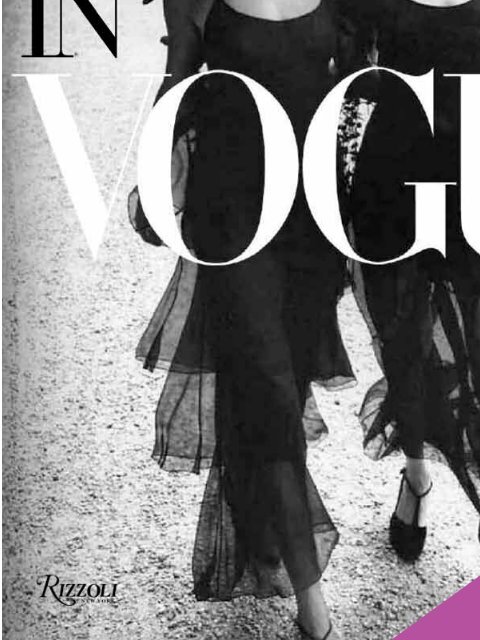
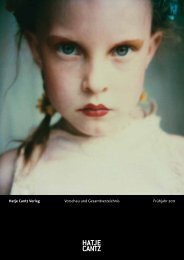

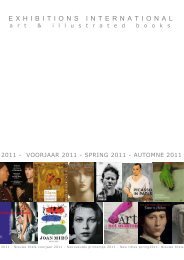
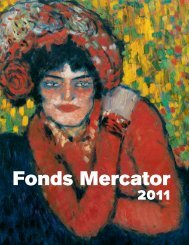
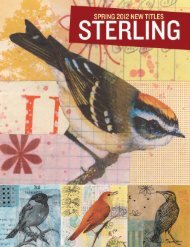

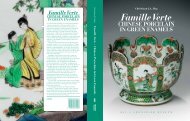
![01 -[BE/INT-2] 2 KOL +UITGEV+ - exhibitions international](https://img.yumpu.com/19621858/1/184x260/01-be-int-2-2-kol-uitgev-exhibitions-international.jpg?quality=85)





